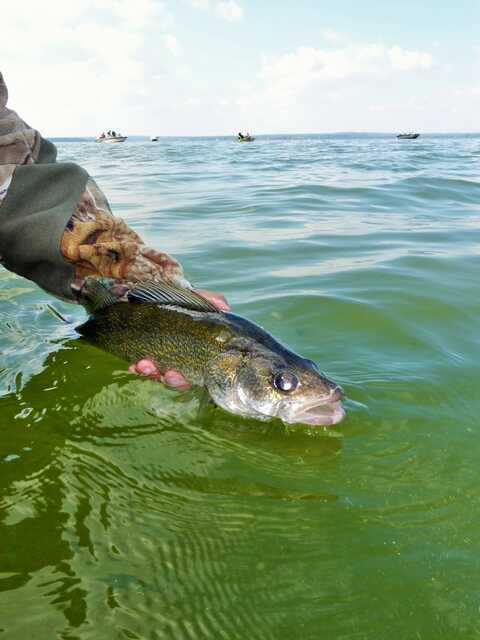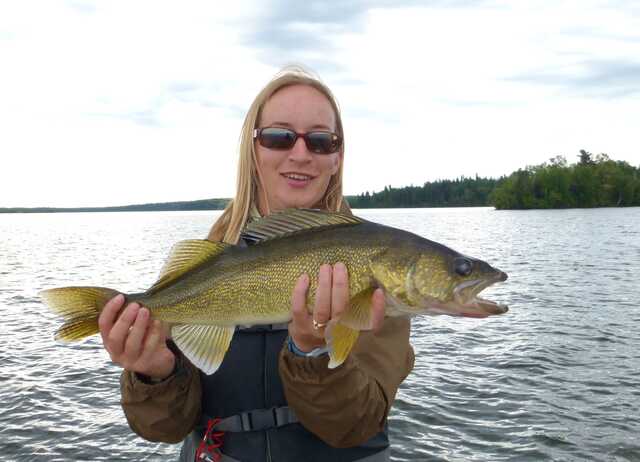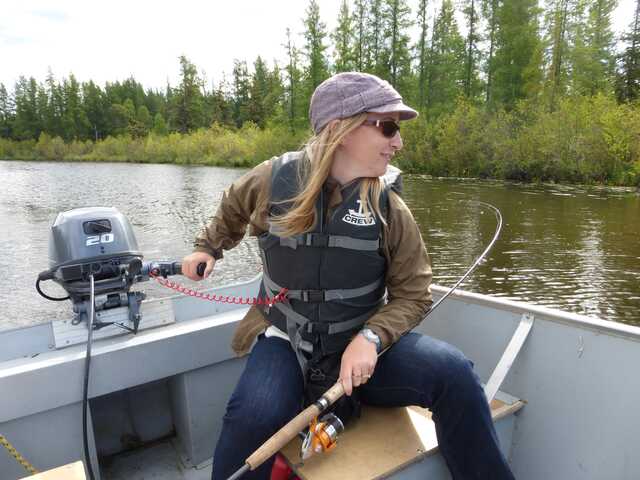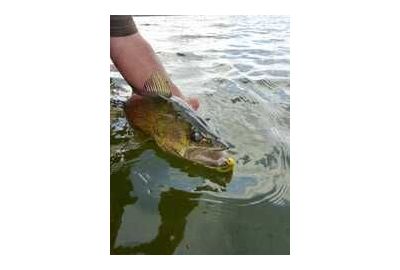It's a perfect summer day. There's a light breeze, its overcast with some sunny breaks, and the temperature is comfortable. I have lots of choices available to me. There is great river fishing, good trout fishing, good pike fishing, and good walleye fishing. I decide I'm going walleye fishing.


To catch summer walleye, it is all about covering water, which translates into engaging the electric motor and trolling to find the aggressive bite. I don't over complicate things. I head out from the boat launch until I hit about 10 feet of water, and that's where I start fishing. Most of the walleye hang out tight to bottom, so that is where I put my bait. I move my boat deeper and shallower in large lazy turns until the fish start biting. I pay attention to my speed, and my depth, so I can get a bead on how fast and how deep I am fishing when a fish bites.


My presentation of choice is to pull blades behind a bottom bouncer. I drop over a 2 oz. bottom bouncer with a pre-tied spinner rig attached and keep the boat moving fast enough to spin the spinner blade. Under tension I slowly let out line until the weight hits bottom, I flip the bail over, and then I'm fishing. The weight will be dragging along bottom or just above bottom, with the spinner rig turning and flashing a few feet behind.


The colour of the spinner rig doesn't matter too much to me, but if you cornered me about which spinner rigs I like the most, they are gold, fire tiger, and a rainbow trout colour. Today I am using a rainbow coloured spinner and on the end I attach a frozen minnow for bait. Worms also work, but my preference is frozen minnows.
There are walleye all over come summer, so I head in the direction that makes most sense, which a lot of times means I am starting out my day trolling into the wind. I'd rather head out trolling into the wind, so if I need to turn and make a run for shore, the wind and waves will be at my back. On this day I'm feeling good about going up the right shoreline, so that's the direction I head. It doesn't take long and my medium heavy rod bends over and starts bucking under the weight of a fish.
Because the boat is moving forward and I'm running braid, which has no stretch, the hook pretty much sets itself. There's no need to set the hook. Instead I pick up the rod and start reeling. In time there is a chunky walleye, right around 50 cm, splashing and sloshing at the back of the boat. I scoop him up with the net and smile, happy to catch my first fish. It's a beauty, and being the first fish of the day, he gets a trip back to the lake. I do love eating walleye, but I know with near certainty that there will be more bites and more opportunities to catch and keep fish so it's an easy decision to let this one go.
I continue trolling and as I move up the shoreline I can tell that I'm fishing over a rocky section, with the sharp taps telegraphing up my line. As best I can tell, the rocks are in 12 to 16 feet and there are lots of fish on the deep edge of these rocks. I keep the boat towards the deeper side and run into all kinds of walleye and the occasional pike. Seeing so many walleye in one spot, and judging the potential drift from the gentle breeze, I cut the motor and decide to drift with a jig and minnow.
While the fishing was good while trolling the spinner rigs, the jig and minnow slowly drifted along bottom was just the ticket and in this hot zone the catching is non-stop. I drop a quarter ounce jig and minnow to the bottom and let the slow drift of the boat do the rest. It takes less than a minute for bites, which makes for an extremely happy day fishing. On the topside, all I do after the jig is on the bottom is put the rod down and wait for it to pull down under the weight of a fish.


Because there's no forward momentum as there is when I'm trolling the boat, hooksets are up to me. So, when I get a bite while drifting the jig, I reel quickly until the rod loads up under the full weight of the fish, then I snap it upward to ensure a good hook set. The hot zone pays big dividends and I catch loads of walleye, selecting one keeper to bring home. The fishing is non-stop and I cannot ask for anything more. I have thoughts of calling it a day and getting home at a decent hour, but before I do, I decide to try one more trick out of my summer walleye tackle box. I pull out a diving plug. This one is a Rapala Tail Dancer, and it's designed to dive 10 to 15 feet, so it should get me close to, if not all the way to the bottom. I imagine when it's doing its thing, it is bouncing off the rocks and stirring up the sand, attracting fish from near and far.
The reason for the plug is two-fold. One, the fishing is hot so, using a plug means I don't have to worry about baiting hooks and two, plugs often get bigger bites. On the way back towards the boat launch I catch a steady assortment of walleye, and a pike that must be closing in on 10 pounds. It's a great fish. I get most of the way back to the boat launch when I get stuck to something heavy. It's a big fish, and it's not running and racing all over like a pike would do. I'm pretty sure I'm attached to a big walleye.
As I gain line, I feel the sharp head shakes of the walleye trying to free itself. And then it happens. It's gone, and I reel in my lure. For a brief moment I feel loss, and I am sad. I would have liked to have seen this fish, but I've caught enough 6 to 9 pounders here to know that this was probably what I was dealing with. I bid the big fish farewell, and a smile returns to my face. It's been a great day, and I feel happy. With the sun still reasonably high and my journey to the boat launch complete, I pack up my gear, already looking forward to the next time I get to chase summer walleye.





